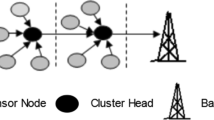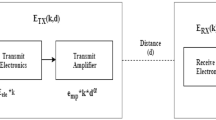Abstract
In the development of cluster-based energy-efficient protocols for wireless sensor networks (WSNs), a particularly challenging problem is the dynamic organization of sensors into a wireless communication network and the routing of sensed information from the field sensors to a remote base station (BS) in a manner that prolongs the lifetime of WSNs. This paper presents a new energy-efficient clustering protocol for WSNs, which can minimize total network energy dissipation while maximizing network lifetime. The protocol is divided into two parts. The first deals with constructing an infrastructure for the given WSN. A newly developed algorithm, based on a harmony search (HS), automatically determines the optimal number of clusters and allocates sensors into these clusters. This algorithm also eliminates the need to set the number of clusters a priori. The second part is concerned with the process of sending sensed data from nodes to their cluster head and then to the BS. A decentralized fuzzy clustering algorithm is proposed, where the selection of cluster heads in each round is locally made in each cluster during the network lifetime. Simulation results demonstrate that the proposed protocol can achieve an optimal number of clusters, prolong the network lifetime and increase the data delivery at the BS, when compared to other well-known clustering-based routing protocols.










Similar content being viewed by others
References
Akyildiz IF, Su W, Sankarasubramaniam Y, Cayirci E (2002) Wireless sensor networks: a survey. Comput Netw 38(4):393–422
Shi H, Liang G, Wang H (2014) A novel traffic identification approach based on multifractal analysis and combined neural network. Annals Telecommunications-annales des Tè,lècommunications 69(3-4):155–169
Kim JW, Barrado JRR, Jeon DK (2016) Time and energy efficient relay transmission for multi-hop wireless sensor networks. Sensors 16(7):985
Saleem M, Di Caro GA (2011) Farooq swarm intelligence based routing protocol for wireless sensor networks: survey and future directions. Inf Sci 181(20):4597–4624
Maskooki A, Soh CB, Gunawan E, Low KS (2015) Adaptive routing for dynamic on-body wireless sensor networks. IEEE J Biomed Health Inform 19(2):549–558
Loutfi A, Elkoutbi M, BenOthman J, Kobbane A (2014) An energy aware algorithm for OLSR clustering. Annals of Telecommunications-annales des Tè,lècommunications 69(3-4):201–207
Razaque A, Elleithy KM (2014) Energy-efficient boarder node medium access control protocol for wireless sensor networks. Sensors 14(3):5074–5117
Kulkarni RV, Venayagamoorthy GK (2011) Particle swarm optimization in wireless-sensor networks: a brief survey. IEEE Trans Syst Man Cybern Part C Appl Rev 41(2):262–267
Ahmed MHU, Razzaque MA, Hong CS (2013) DEC-MAC: delay-and energy-aware cooperative medium access control protocol for wireless sensor networks. Annals of Telecommunications-annales des Tè,lècommunications 68 (9-10):485–501
Umar IA, Mohd Hanapi Z, Sali A, Zulkarnain ZA (2016) FuGeF: a resource bound secure forwarding protocol for wireless sensor networks. Sensors 16(6):943
Yick J, Mukherjee B, Ghosal D (2008) Wireless sensor network survey. Comput Netw 52(12):2292–2330
Al-Karaki JN, Kamal AE (2004) Routing techniques in wirless sensor networks: a survey. IEEE Wirel Commun 11(6):6–28
Liu X (2012) A survey on clustering routing protocols in wireless sensor networks. Sensors 12(8):11113–11153
Alia OM (2017) Dynamic relocation of mobile BS in wireless sensor networks using a cluster-based harmony search algorithm. Inf Sci 385:76–95
Fu P, Cheng Y, Tang H, Li B, Pei J, Yuan X (2017) An effective and robust decentralized target tracking scheme in wireless camera sensor networks. Sensors 17(3):639
Ren P, Qian J (2016) A power-efficient clustering protocol for coal mine face monitoring with wireless sensor networks under channel fading conditions. Sensors 16(6):835
Xu L, O’Hare GM, Collier R (2017) A smart and balanced energy-efficient multihop clustering algorithm (smart-BEEM) for MIMO IoT systems in future networks. Sensors 17(7):1574
Srie Vidhya Janani E, Ganesh Kumar P (2015) Energy efficient cluster based scheduling scheme for wireless sensor networks. Sci World J 2015, Article ID 185198, p 9
Yu J, Feng L, Jia L, Gu X, Yu D (2014) A local energy consumption prediction-based clustering protocol for wireless sensor networks. Sensors 14(12):23017–23040
Mustapha I, Ali BM, Rasid MFA, Sali A, Mohamad H (2015) An energy-efficient spectrum-aware reinforcement learning-based clustering algorithm for cognitive radio sensor networks. Sensors 15(8):19783–19818
Gao Y, Wkram CH, Duan J, Chou J (2015) A novel energy-aware distributed clustering algorithm for heterogeneous wireless sensor networks in the mobile environment. Sensors 15(12):31108–31124
Ogundile OO, Alfa AS (2017) A survey on an energy-efficient and energy-balanced routing protocol for wireless sensor networks. Sensors 17(5):1084
Heinzelman WR, Chandrakasan A, Balakrishnan H (2000) Energy-efficient communication protocol for wireless microsensor networks. In: Proceedings of the 33rd Annual Hawaii International Conference on System Sciences, vol 2, pp 1–10
Heinzelman WB, Chandrakasan AP, Balakrishnan H (2002) An application-specific protocol architecture for wireless microsensor networks. IEEE Trans Wirel Commun 1(4):660–670
Younis O, Fahmy S (2004) HEED: A hybrid, energy-efficient, distributed clustering approach for ad-hoc sensor networks. IEEE Trans Mob Comput 3(4):366–379
Qing L, Zhu Q, Wang M (2006) Design of a distributed energy efficient clustering algorithm for heterogeneous wireless sensor networks. Comput Commun 29(12):2230–2237
Lindsey S, Raghavendra C, Sivalingam KM (2002) Data gathering algorithms in sensor networks using energy metrics. IEEE Trans Parallel Distributed Syst 13(9):924–935
Manjeshwar A, Agrawal DP (2001) TEEN: a routing protocol for enhanced efficiency in wireless sensor networks. In: Proceedings of the 15th International Parallel and Distributed Processing Symposium (IPDPS), San Francisco, CA, USA, pp 2009–2015
Smaragdakis G, Matta I, Bestavros A (2004) SEP: a stable election protocol for clustered heterogeneous wireless sensor networks. In: Proceedings of the International Workshop on SANPA, pp 251–261
Julie EG, Selvi S (2016) Development of energy efficient clustering protocol in wireless sensor network using neuro-fuzzy approach. Sci World J 2016, Article ID 5063261, p 8
Liaqat M, Gani A, Anisi MH, Ab Hamid SH, Akhunzada A, Khan MK, Ali RL (2016) Distance-based and low energy adaptive clustering protocol for wireless sensor networks. PloS one 11(9):e0161340
Zhang Y, Wang J, Han D, Wu H, Zhou R (2017) Fuzzy-logic based distributed energy-efficient clustering algorithm for wireless sensor networks. Sensors 17(7):1554
Hematkhah H, Kavian YS (2015) DCPVP: distributed clustering protocol using voting and priority for wireless sensor networks. Sensors 15(3):5763–5782
Beulah Jayakumari R, Jawahar Senthilkumar V (2015) Priority based congestion control dynamic clustering protocol in mobile wireless sensor networks, Sci World J, 2015, Article ID 596138, p 10
Han R, Yang W, Wang Y, You K (2017) 2017 DCE: a distributed energy-efficient clustering protocol for wireless sensor network based on double-phase cluster-head election. Sensors 17(5):998
Alia OM, Mandava R, Ramachandram D, Aziz ME (2009) Dynamic fuzzy clustering using harmony search with application to image segmentation. In: Proceedings of the IEEE International Symposium on Signal Processing and Information Technology, ISSPIT09, pp 538–543
Alia OM, Mandava R, Aziz M (2011) A hybrid harmony search algorithm for MRI brain segmentation. Evol Intell., Springer-Verlag 4(1):31–49
Hruschka ER, Campello RJ, Freitas AA, Carvalho AC (2009) A survey of evolutionary algorithms for clustering. IEEE Trans Syst Man Cybern Part C Appl Rev 39(2):133–155
Latiff NA, Tsimenidis CC, Sharif BS, Ladha C (2008) Dynamic clustering using binary multi-objective particle swarm optimization for wireless sensor networks. In: IEEE International Symposium on Personal, Indoor and Mobile Radio Communications (PIMRC), pp 1–5
Falkenauer E (1998) Genetic algorithms and grouping problems. Wiley, New York
Huang S, Tao M (2017) Competitive swarm optimizer based gateway deployment algorithm in cyber-physical systems. Sensors 17(1):209
Saleem K, Derhab A, Orgun MA, Al-Muhtadi J, Rodrigues JJ, Khalil MS, Ali Ahmed A (2016) Cost-effective encryption-based autonomous routing protocol for efficient and secure wireless sensor networks. Sensors 16(4):460
Geem ZW, Kim JH, Loganathan GV (2001) A new heuristic optimization algorithm: harmony search. Simulation 76(2):60–68
Alia OM, Al-Ajouri A (2017) Maximizing wireless sensor network coverage with minimum cost using harmony search algorithm. IEEE Sensors J 17(3):882–896
Alia OM, Mandava R (2011) The variants of the harmony search algorithm: an overview. Artif Intell Rev 36(1):49–68
Alia OM, Shaaban Z, Basheer A, Al-Ajouri A, Alsswey A (2014) Musicians’-inspired clustering protocol for efficient energy wireless sensor networks. In: Proceedings of the Fourth International Conference on Communications and Networking (ComNet’14), pp 1–6
Wang A, Heinzelman WB, Sinha A, Chandrakasan AP (2001) Energy-scalable protocols for battery-operated microsensor networks. J VLSI Signal Process Syst Signal, Image Video Technol 29(3):223–237
Geem ZW, Tseng CL, Park Y (2005) Harmony search for generalized orienteering problem: best touring in China. In: International Conference on Natural Computation. Springer, Berlin, pp 741–750
Pakhira MK, Bandyopadhyay S, Maulik U (2004) Validity index for crisp and fuzzy clusters. Pattern Recogn 37(3):487–501
Bezdek JC (1981) Pattern recognition with fuzzy objective function algorithms. Kluwer Academic Publishers, Norwell
Wang W, Zhang Y (2007) On fuzzy cluster validity indices. Fuzzy Sets Syst 158(19):2095–2117
Halkidi M, Batistakis Y, Vazirgiannis M (2001) On clustering validation techniques. J Intell Inf Syst 17 (2):107–145
Alia OM (2014) A decentralized fuzzy C-means-based energy-efficient routing protocol for wireless sensor networks. Sci World J, 2014, Article ID 647281, p 9
Acknowledgments
The author gratefully acknowledges the support received in the course of this study from the Sensor Networks and Cellular Systems Research Center, the University of Tabuk, and the Ministry of Education in Saudi Arabia.
Author information
Authors and Affiliations
Corresponding author
Rights and permissions
About this article
Cite this article
Alia, O.M. A dynamic harmony search-based fuzzy clustering protocol for energy-efficient wireless sensor networks. Ann. Telecommun. 73, 353–365 (2018). https://doi.org/10.1007/s12243-017-0611-6
Received:
Accepted:
Published:
Issue Date:
DOI: https://doi.org/10.1007/s12243-017-0611-6




